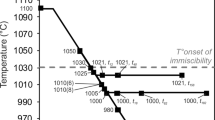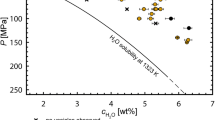Abstract
At 1,175°C-1 bar, muscovite in natural granite powders is completely transformed after 5 min. Due to the overlapping of several processes such as dehydroxylation, mineralogical transformations, collapse and sintering of transformed lamellae, a few parts per thousand of H2O vapor are trapped, generating bubbles in muscovite pseudomorphs. For short durations (5–40 min), the crystallographic properties of the precursor muscovite control the geometry of the bubbles that may be compared to thick disks with a rounded shape in basal sections and an elongated shape in lateral section, parallel to the former cleavage planes of muscovite. With longer durations the bubbles change from thick disks to spheres, which can be explained by the release of constraints perpendicular to basal planes upon growth of the high temperature Si–Al oxides. With time, the number of bubbles decreases while the bubble size and the porosity of the pseudomorphs increase. Bubble behavior was analyzed in terms of ripening, shape transformations and coalescence.











Similar content being viewed by others
References
Adamson AW (1976) Physical chemistry of surfaces. Wiley, New York, p 698
Barlow SG, Manning DAC (1999) Influence of time and temperature on reactions and transformations of muscovite mica. Br Ceram Trans 98:122–126
Brearley AJ (1986) An electron optical study of muscovite breakdown in pelitic xenoliths during pyrometamorphism. Mineral Mag 50:385–397
Brindley GW, Maroney D (1960) High-temperature reactions of clay mineral mixtures and their ceramic properties: II, reactions of kaolinite-mica-quartz mixtures compared with the K2O–Al2O3–SiO2 equilibrium diagram. J Am Ceram Soc 43:511–516
Brindley GW, Lemaître J (1987) Thermal, oxidation and reduction reactions of clay minerals. In: Newman ACD (ed) Chemistry of clays and clay minerals. Mineralogical Society, London, pp 319–370
Cultrone G, Rodriguez-Navarro C, Sebastian E, Cazalla O, de la Torre MJ (2001) Carbonate and silicate phase reactions during ceramic firing. Eur J Mineral 13:621–634
Davis KM, Tomozawa M (1996) An infrared spectroscopic study of water-related species in silica glasses. J Non-Cryst Solids 201:177–198
Deganello G, Liotta L, Longo A, Martorana A, Yanev Y, Zotov N (1998) Structure of natural water-containing glasses from Lipari (Italy) and Eastern Rhodopes (Bulgaria): SAXS, WAXS and IR studies. J Non-Cryst Solids 232–234:547–553
Devineau K (2002) Destabilisation haute température de poudres granitiques: évolution des propriétés minéralogiques et physiques. Doctorat I.N.P.L., Nancy, pp 334
Devineau K, Pichavant M, Villiéras F (2005) Melting kinetics of granitic powder aggregates at 1175°C, 1 atm. Eur J Mineral 17:387–398
Devineau K, Devouard B, Villiéras F, Faure F, Devidal JL, Kohler A (2006) Evolution of product phase assemblages during thermal decomposition of muscovite under strong disequilibrium conditions. Am Mineral 91:413–424
Eberhart J (1963) Transformation de la muscovite par chauffage entre 700 et 1200°C. Bull Soc Fr Minér Crist 86:213–251
Gaines G, Vedder W (1964) Dehydroxylation of muscovite. Nature 201:495
Grapes RH (1986) Melting and thermal reconstitution of pelitic xenoliths, Wehr Volcano, East Eifel, West Germany. J Petrol 27:343–396
Hagymassy J, Brunauer S, Mikhail RSh (1969) Pore structure analysis by water vapor adsorption. I. t-curves for water vapor. J Coll Interf Sci 29:485–491
Mackenzie KJD, Brown IWN, Cardile CM, Meinhold RH (1987) The thermal reactions of muscovite studied by high resolution solid-state 29-Si and 27-Al NMR. J Mat Sci 22:2645–2654
Moecher DP, Brearley AJ (2004) Mineralogy and petrology of a mullite-bearing pseudotachylyte: constraints on the temperature of coseismic frictional fusion. Am Mineral 89:1486–1495
Murase T, McBirney AR (1973) Properties of some common igneous rocks and their melts at high temperature. Geol Soc Am Bul 84:3563–3592
O’Hara KD, Sharp ZD (2001) Chemical and oxygen isotope composition of natural and artificial pseudotachylyte: role of water during frictional fusion. Earth Planet Sci Lett 184:393–406
Oehler A, Tomozawa M (2004) Water diffusion into silica glass at a low temperature under high water vapor pressure. J Non-Cryst Solids 347:211–219
Pichavant M, Manning DAC (1984) Petrogenesis of tourmaline granites and topaz granites: the contribution of experimental data. Phys Earth Planet Int 35:31–50
Rodriguez-Navarro C, Cultrone G, Sanchez-Navas A, Sebastian E (2003) TEM study of mullite growth after muscovite breakdown. Am Mineral 88:713–724
Roy R (1949) Decomposition and resynthesis of the micas. J Am Ceram Soc 32:202–209
Sundius N, Byström AM (1953) Decomposition products of muscovite at temperatures between 1000 and 1260°C. Trans Brit Ceram Soc 52:632–642
Tite MS, Maniatis Y (1975) Examination of ancient pottery using the scanning electron microscope. Nature 257:123–123
Vedder W, Wilkins R (1969) Dehydroxylation and rehydroxylation, oxidation and reduction of micas. Am Mineral 54:482–509
Villiéras F, Chamerois M, Bardot F, Michot LJ (2002) Evaluation of wetting properties of powders from gas adsorption experiments. In: Mittal KL (ed) Contact angle, wettability and adhesion, vol 2. VSP, Utrecht, pp 435–447
Worden RH, Champness PE, Droop GTR (1987) Transmission electron microscopy of the pyrometamorphic breakdown of phengite and chlorite. Mineral Mag 51:107–121
Acknowledgments
We are indebted to Adrian Brearley and one anonymous reviewer for their careful and constructive reviews of the manuscript. Assistance by A. Kohler on the scanning electron microscopy and by L. Filippov with the Scion Image software are gratefully acknowledged. We thank C. Constantin for the preparation of petrographic sections. K.D. expresses her thanks and gratitude to The Société de Secours des Amis des Sciences and to the Laboratoire Environnement et Minéralurgie, UMR 7569 CNRS-INPL, Nancy University for the grants.
Author information
Authors and Affiliations
Corresponding author
Rights and permissions
About this article
Cite this article
Devineau, K., Villiéras, F. & Barrès, O. Development and evolution of water vapor vesicles during fast thermal breakdown of muscovite. Phys Chem Minerals 34, 559–572 (2007). https://doi.org/10.1007/s00269-007-0171-9
Received:
Accepted:
Published:
Issue Date:
DOI: https://doi.org/10.1007/s00269-007-0171-9




